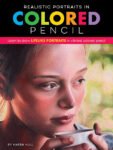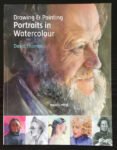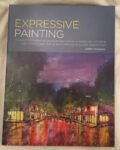Time for another book review and today it’s this one by Alyona Nickelsen. It’s a 184 page paperback. I’ll say right from the off that this isn’t a well written book. Stuff was presented to the readers in the wrong order, often out of context or with important questions remaining unanswered. It wouldn’t make any sense for me to go through this book chapter by chapter without you knowing what the overall story was, so I’m going to tell you that up front. Then maybe you’ll appreciate what a mess this book was.
The cover of the book promises a “revolutionary method” for coloured pencil portraits. I’m guessing (because Alyona never actually comes out and says it) that this method is all about doing portraits in multiple layers, with the layers separated by coatings of textured fixative. Textured fixative leaves behind a surface that is, well, textured and suitable for drawing on in coloured pencil. If you’re wondering what this methodology can do that you couldn’t do just by applying layer after layer of pencil, I reckon there are three things. First, layer after layer of coloured pencil will eventually fill up the tooth of the paper whereas every time you spray on textured fixative it creates the capacity for more colour. So with textured fixative you can add many more layers. Second, two layers of colour separated by fixative actually look as different to one colour applied on top of the other as a watercolour layer glazed over another colour would look different to the two colours mixed together. Third, and I’m less sure about this one, if you use powdered blended to blend the colours in one layer you need something on top to fix it down so it doesn’t blow away. Don’t quote me on that third one though – it’s just an impression I get rather than something I’ve read or heard. And that’s what the book is about. Alyona should really have come out and said this in the first chapter.
Anyway, chapter-wise, we have:
– about 25 pages of introduction and the coloured pencil revolution
– about 15 pages on the rules of the game
– about 10 pages on working the medium
– about 20 pages on controlling colour
– about 15 pages on portrait fact and fiction
– about 50 pages on practising the essentials
– about 35 pages on keeping friends and clients happy
– about 10 pages of afterwords, index and an appendix
Yeah, that roughly balances. Let’s go through them.
The Coloured Pencil Revolution
I’ve already pointed out that we’re missing some important stuff here. There’s nothing there to tell us what the whole book’s about. No indication of what this revolutionary method actually is.
There’s a lot of guff comparing coloured pencils to oil painting, sounding like an attempt to justify coloured pencil painting as proper artwork. People buying this book already want to paint in coloured pencil, so aren’t the ones that need to be won over. What a waste of space.
And then we get on to equipment and materials. There’s stuff about what paper to use. Later in the book we’re told that sanded paper works best with the techniques here but this doesn’t get mentioned here. We’re told about fixatives but not why. We’re told about liquid blenders, powdered blenders, titanium white powder but not why. Liquid blenders don’t even get used in the rest of the book so why are they here at all? There’s discussion of studios and lighting which I admit I’ve not seen in other books but, really, this opening chapter is atrocious.
Rules Of The Game
OK. This is the important chapter. It talks about old oil painters and how they’d paint in five layers: the imprimatura, the underpainting, the veiling or dead layer, the colour layers and the highlights. This is the technique Alyona is trying to teach us but you wouldn’t know it. It seems to be written with oil paintings in mind, although on a second reading there are subtle hints that it also applies to coloured pencils. It’s the way it’s worded. Artists do this, artists do that. As if this is a long established technique and not the revolutionary technique for coloured pencils that we’re promised. And the first of those layers barely features in the rest of the book and there’s no mention of the fixative that would need to go on between layers in a coloured pencil painting. This is another really badly written chapter. If Alyona is telling us this is what she wants is to do with coloured pencil then she should say so. I’m wondering now whether she’s a poor teacher as well as a poor writer.
Working The Medium
We’re getting closer to the point of the book. We’re told about the advantages of drawing on rough surfaces and a bit about using solvents and texture fixative. I don’t know why solvents get mentioned at all as they don’t have a role to play in this revolutionary technique. Powdered blender, which does have an important role to play, barely gets a mention and my question about whether it needs to be fixed to prevent it blowing away doesn’t get answered.
Controlling Colour
A well written chapter at last, covering things like colour mixing and colour intensity (called saturation in other places but let’s not get picky). But there’s also some interesting stuff on opacity and transparency including where on a painting to use opaque and transparent layers of colour and how to make coloured pencil transparent or opaque. Yeah, credit where credit’s due, a decent chapter.
Portrait Fact And Fiction
Now we’re finally on to portraits. I wouldn’t mind but I’ve still not been told what this revolutionary method is. This is a chapter on portrait composition. Not the usual stuff about focal points and the rule of thirds but some ideas on pose, lighting and attitude. I’ve nothing much to say about this chapter.
Practising The Essentials
We start with a few general tips, of which I found the stuff on skin tones most useful. After that, we’re on to facial elements. We’re given some tips on each element and a series of demonstrations that, while complete portraits in some cases, are focussed on those particular elements. So we have two demos on skin, three on hair, three on eyes, two on the mouth, one on the nose, one on nose and chin, two on ears, two on hands and one on a foot. I make that seventeen. These are proper demonstrations rather than paint-along-with-me exercises. And it’s only in reading through this chapter, and seeing how all these demos have an underpainting layer, textured fixative, a veiling or dead layer, textured fixative, coloured layers (maybe separated by textured fixative ) and final fixative that I actually understood what the revolutionary technique was.
Keeping Friends And Clients Happy
The final chapter has a bit of advice on commissions and is then followed by five demonstrations of complete portraits. Before the demonstrations we’re told what gear Alyona uses in these demos. It’s the same gear that she was using in the previous chapter (I was making a mental note) and it’s the gear that she should have been discussing and recommending in that chapter at the beginning of the book. I can’t believe what a jumble this book is. Oh, and although these demos are worded as demos, Alyona tells us at some point that we should be trying to replicate them ourselves. Were we supposed to be doing that in the last chapter too? Did I miss something? I don’t really care to be honest. I didn’t learn much from these five demos: the more interesting bits were at the start of each one where Alyona discussed the subject and the style of portrait she wanted to create.
Afterword And Appendix
I’ve just seen this quote in the afterword and I’m staggered. “My goal in writing this book was to put together a comprehensive work that makes the case for colored pencil to be considered a serious art medium with significant potential, using the portrait genre as an example.” Take note people. Alyona’s goal wasn’t to make you a better coloured pencil portrait artist: it was to get more respect for coloured pencil. It just says it all.
Oh, and there’s an appendix that gives traffic light ratings to how well eight different blenders work with twelve different makes of coloured pencil on two different types of surface. The two surface types are absorbent cotton-based and non-absorbent textured supports. Where does the non-cotton watercolour paper from Seawhites of Brighton fit in? I have no idea. And these eight different blenders. How many of them are used in the demos? None. The only blender used in the demos is powdered blender and that doesn’t get a mention!
Before we get to the rating, what do I think about the very badly described revolutionary method for coloured pencil portraits? Well, the proof will be in the pudding. But to give the methodology a go I would need to buy some textured fixative, some final fixative, some powdered blender and applicators for the blender. I think we’re talking £60-70. I could give these all a go on Seawhite paper but there would be risks involved as the fixatives go quite hard and could crack if I bent the paper. So I might have to invest in sanded paper but that’s about £6 a sheet! It would be an expensive business following the techniques in this book. Not only that but would I enjoy it? In the opening pages Alyona talks about how one of the great things about coloured pencil is that it’s clean. I’m not sure that would still be the case if I were spraying fixative everywhere and having to hoover up powdered blender off the floor. Still it would make the studio look nice at Christmas. The time spent waiting for fixative to dry would also detract from the fun. So I’m still in two minds about whether to try out these techniques. I might experiment with using an alcohol marker blender though.
The rating? Well it’s not getting three+ palettes. Anything with three palettes goes down as a book recommendation from me and there’s no way on earth that I’d recommend as badly written a book as this, even if the techniques do turn out to be revolutionary. On the other hand, do I regret reading it? Not really. I’m glad that I know about these techniques, even if I have no immediate plans to use them. I think I’m talking myself into giving this one two palettes but that’s through gritted teeth. I hated this book with a passion. If anyone ever writes a better book on the same technique, this rating will be dropping to one palette.
🎨🎨









Leave a Reply